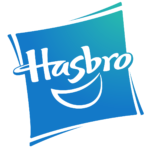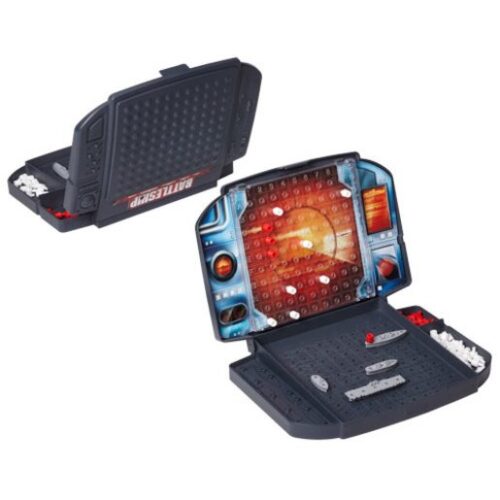Battleship
Battleship is a classic two-player strategy game that centers on naval warfare, challenging players to locate and sink their opponent’s fleet of ships before their own ships are destroyed. Known for its simple rules, high-stakes guessing, and suspenseful gameplay, Battleship is a mainstay in board game collections and has been reimagined in various digital, movie, and video game formats.

Original price was: £6.33.£6.01Current price is: £6.01.
Description
Battleship is a classic two-player strategy game that centers on naval warfare, challenging players to locate and sink their opponent’s fleet of ships before their own ships are destroyed. Known for its simple rules, high-stakes guessing, and suspenseful gameplay, Battleship is a mainstay in board game collections and has been reimagined in various digital, movie, and video game formats.
Overview and Components
- Game Setup:
- Battleship is typically played on two separate grids for each player. Each grid has a vertical and horizontal axis labeled with coordinates, usually A-J and 1-10.
- Each player places their fleet of ships on the grid in secret. Ships must be arranged either horizontally or vertically, and they cannot overlap or be placed diagonally.
- Fleet of Ships:
- Standard versions of Battleship include five ships of different lengths:
- Aircraft Carrier: 5 spaces
- Battleship: 4 spaces
- Submarine: 3 spaces
- Destroyer: 3 spaces
- Patrol Boat: 2 spaces
- Each ship occupies a set number of spaces on the grid, and their sizes vary, which affects how players strategize both placement and attacks.
- Standard versions of Battleship include five ships of different lengths:
- Gameplay Mechanics:
- Players take turns calling out coordinates (e.g., “B7”) to “fire” on the opponent’s grid. The opponent then responds with “hit” if the shot lands on a ship, or “miss” if it lands in an empty space.
- Players keep track of hits and misses on a separate tracking grid to monitor where they’ve guessed and where their opponent’s ships might be hiding.
- Winning the Game:
- The goal is to sink all of your opponent’s ships by hitting every occupied space. A ship is considered “sunk” when all of its spaces have been hit. The first player to sink all of their opponent’s ships wins.
Strategy and Variations
- Ship Placement: The key to effective ship placement is balance. Some players prefer clustering ships together to create a “hot zone” that’s hard to penetrate, while others spread them out to avoid giving any clues to the opponent.
- Guess Patterns: A good guessing pattern can quickly reveal or eliminate possibilities. For example, players often employ a checkerboard strategy to scan the board efficiently.
- Advanced Variations: In certain versions, special features or house rules can be added. Some versions include power-ups, special attacks, or varied ship arrangements.
Electronic and Digital Versions
Battleship has been adapted into electronic and digital formats that offer various levels of interaction and complexity:
- Electronic Battleship: The electronic version adds sound effects, light-up indicators, and sometimes even a “radar” feature. It automates the hit-or-miss response, adding another layer of immersion.
- Video Game and Mobile Versions: Video game and mobile versions bring enhanced graphics, animations, and sometimes additional game modes or special abilities. These digital versions allow for single-player modes against AI or multiplayer against other players online.
Educational Value and Appeal
- Educational Benefits:
- Spatial Reasoning: Placing ships and choosing coordinates for attacks require spatial awareness.
- Logical Thinking: Players develop critical thinking by deducing possible ship locations and strategizing attacks.
- Memory Skills: Keeping track of past hits and misses reinforces memory and observational skills.
- Appeal:
- Battleship’s simple yet suspenseful gameplay makes it popular across age groups. It’s accessible to children learning strategy and spatial reasoning but remains challenging enough for adults.
- The anticipation of hits or misses and the satisfaction of sinking an opponent’s ship contribute to its enduring appeal.
Variants and Spin-offs
- Battleship: Command: This variant introduces missions and objectives beyond simply sinking ships, adding layers of tactical and strategic options.
- Battleship in Pop Culture: The game has inspired movies, video games, and themed versions featuring iconic characters and franchises.
Summary
Battleship remains a beloved game for its blend of strategy, suspense, and simple rules. Its adaptability to digital formats and its educational value reinforce its role as a timeless game that has continued to entertain and challenge players for generations.
Battleship Prices
Price History
Brand
Brand
Hasbro
- Iconic Brands: Hasbro is the owner of numerous iconic brands and franchises, including Monopoly, Nerf, Transformers, My Little Pony, G.I. Joe, Play-Doh, and Dungeons & Dragons. These brands have transcended their original toys and games to become cultural touchstones and media phenomena.
- Innovative Toys and Games: Hasbro is renowned for its innovation in toy and game design. The company has introduced classics like the Easy-Bake Oven, Mr. Potato Head, and Twister, as well as modern hits like FurReal Friends and Baby Alive. Many of its games, like Scrabble and Battleship, have become household names.
- Media Integration: Hasbro has successfully leveraged its toy and game properties into a wide range of entertainment media, including animated series, movies, and digital games. Transformers and My Little Pony are prime examples of franchises that have found success in multiple forms of media.
- Licensed Properties: Hasbro has acquired licenses for popular franchises such as Star Wars, Marvel, and Disney Princess, allowing the company to produce a wide range of toys, games, and collectibles tied to these beloved properties.
- Community and Events: Hasbro has a dedicated community of fans and enthusiasts who participate in events like HasCon and Hasbro Pulse Fan Fest. These gatherings provide opportunities for fans to connect with one another and experience the latest Hasbro products.
- Global Reach: Hasbro's influence extends worldwide, with a presence in over 130 countries. The company's commitment to diversity and inclusion is reflected in its diverse product offerings and global partnerships.

- Iconic Brands: Hasbro is the owner of numerous iconic brands and franchises, including Monopoly, Nerf, Transformers, My Little Pony, G.I. Joe, Play-Doh, and Dungeons & Dragons. These brands have transcended their original toys and games to become cultural touchstones and media phenomena.
- Innovative Toys and Games: Hasbro is renowned for its innovation in toy and game design. The company has introduced classics like the Easy-Bake Oven, Mr. Potato Head, and Twister, as well as modern hits like FurReal Friends and Baby Alive. Many of its games, like Scrabble and Battleship, have become household names.
- Media Integration: Hasbro has successfully leveraged its toy and game properties into a wide range of entertainment media, including animated series, movies, and digital games. Transformers and My Little Pony are prime examples of franchises that have found success in multiple forms of media.
- Licensed Properties: Hasbro has acquired licenses for popular franchises such as Star Wars, Marvel, and Disney Princess, allowing the company to produce a wide range of toys, games, and collectibles tied to these beloved properties.
- Community and Events: Hasbro has a dedicated community of fans and enthusiasts who participate in events like HasCon and Hasbro Pulse Fan Fest. These gatherings provide opportunities for fans to connect with one another and experience the latest Hasbro products.
- Global Reach: Hasbro's influence extends worldwide, with a presence in over 130 countries. The company's commitment to diversity and inclusion is reflected in its diverse product offerings and global partnerships.




















